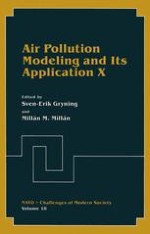1994 | OriginalPaper | Buchkapitel
Observation and Simulation of Urban-Topography Barrier Effects on Boundary Layer Structure Using the Three-Dimensional TVM/URBMET Model
verfasst von : R. Bornstein, P. Thunis, G. Schayes
Erschienen in: Air Pollution Modeling and Its Application X
Verlag: Springer US
Enthalten in: Professional Book Archive
Aktivieren Sie unsere intelligente Suche, um passende Fachinhalte oder Patente zu finden.
Wählen Sie Textabschnitte aus um mit Künstlicher Intelligenz passenden Patente zu finden. powered by
Markieren Sie Textabschnitte, um KI-gestützt weitere passende Inhalte zu finden. powered by
Urban areas affect prevailing mesoscale and synoptic flow patterns due to a variety of physical processes, including urban heat island induced accelerations, surface roughness induced decelerations, and building barrier effects. Analysis of data collected over New York City (NYC) has shown that the city is capable of significantly altering the speed and/or direction of movement of thunderstorm cells, sea breeze fronts, and synoptic fronts. Analyses of the above effects, plus additional analysis (during periods without such features) of surface flow patterns, surface convergence fields, tetroon vertical velocities, and double theodolite velocity fields all point to the urban barrier effect as the most significant factor altering mesoscale flow over NYC (Bornstein and LeRoy1).
